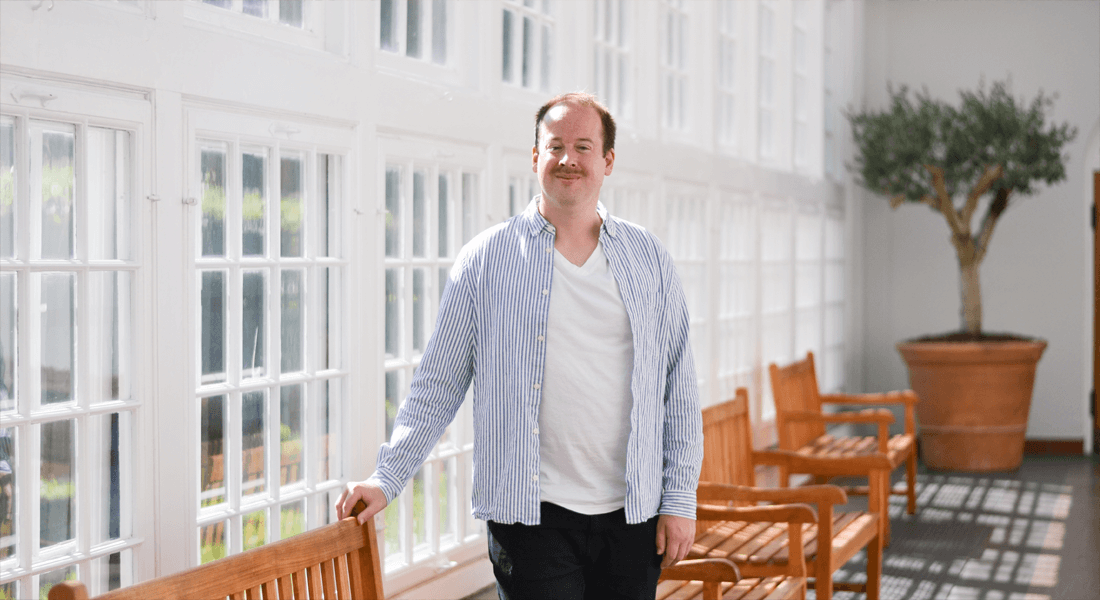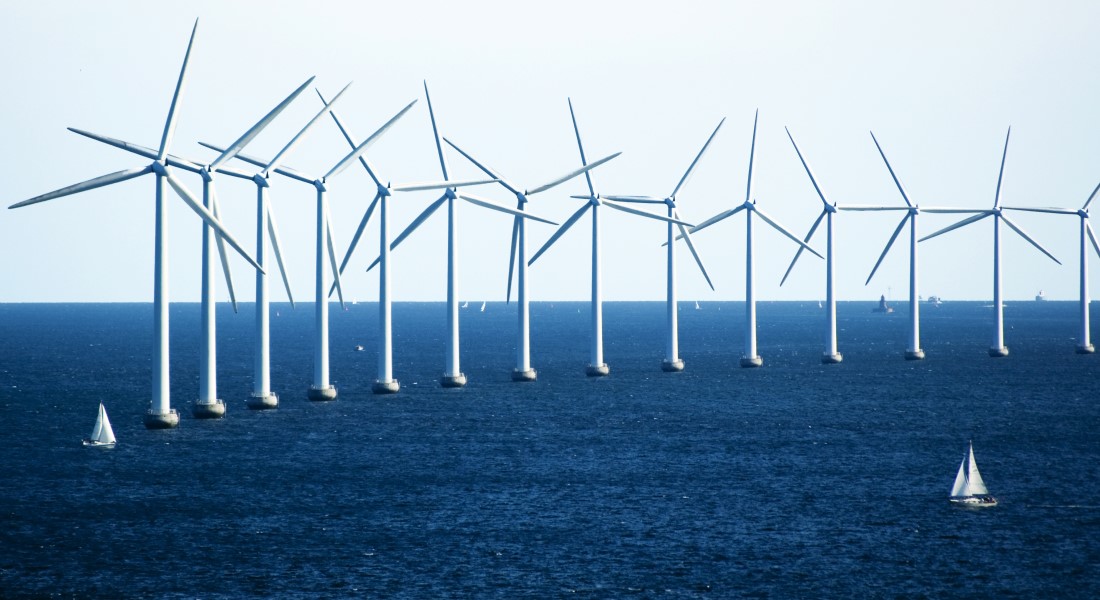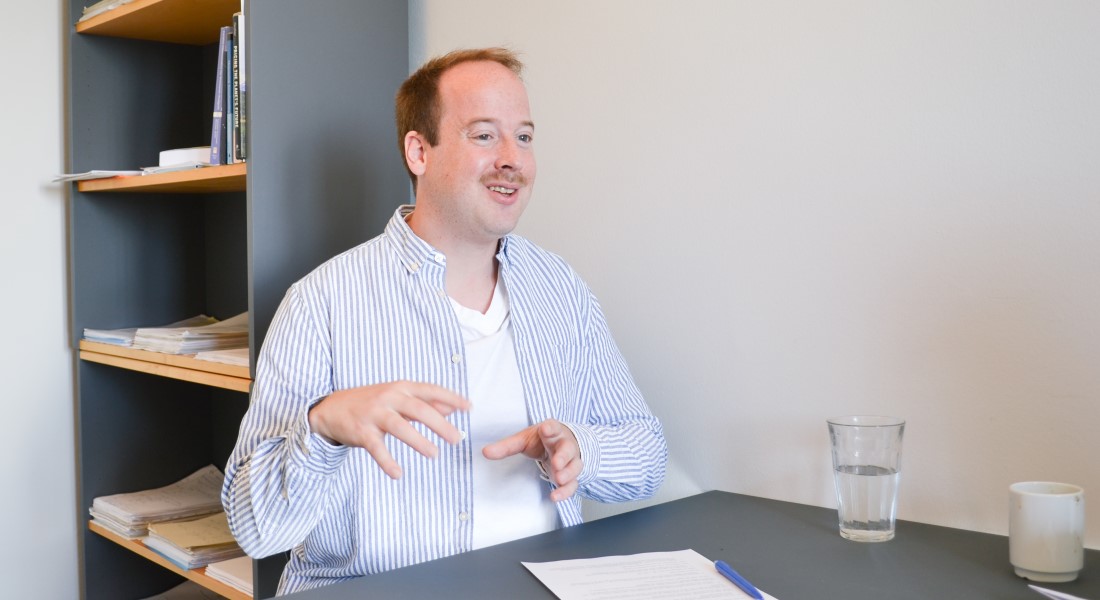Economics of climate change: One per cent makes a world of difference
Frikk Nesje and his colleagues have created international awareness by building bridges in the political debate as to how much we should invest in the climate. Here, the social discount rate in the economic models of climate change is such a key factor that even the White House wanted to know more.

In early June, a message suddenly ticked in from Washington: Economists from President Biden's administration wanted to hear more about the work, which Frikk Nesje and his international colleagues had done in the climate field. An online meeting was quickly organised and, suddenly, Frikk Nesje had access to the engine room of the world's largest economy.
“It was a nice surprise. Someone in the White House had read our scientific paper. At the same time, it is good to see that the research can contribute to more informed choices,” says Frikk Nesje sitting in his modest office at the UCPH Department of Economics.
He joined the department last year as an assistant professor following research stays in Oslo, London, Evanston and Heidelberg bringing insight into the economics of climate change, a research that has drawn international attention to the 33-year-old Norwegian and given him several awards.
"It is about how much we need to prioritise the long-term, somewhat diffuse climate problem in relation to all the other concrete challenges we as a society face here and now.
Frikk Nesje's research, which also the Americans wanted to know more about, has its main focus on the 'social discount rate' in the climate economic models. A concept that is as technical as it is crucial when it comes to estimating how much we as a society can invest in the climate without – commonly speaking – squandering the money.
“The choice of social discount rate has major consequences in the climate area,” emphasises Frikk Nesje.
"It is about how much we need to prioritise the long-term, somewhat diffuse climate problem in relation to all the other concrete challenges we as a society face here and now. Translated into politics: How comprehensive should our regulation be?"
Specifically, the social discount rate is the annual interest rate that economists use to convert future costs and gains to present value, in order that we may better assess how many resources it makes sense to invest in projects with a long horizon – such as investments in the climate (see box).
”The higher the social discount rate, the greater the benefit of climate investments must be for future generations in order for us to be willing to implement the investment. Thus, a high social discount rate means that we put less emphasis on future generations and their climate problems,” says Frikk Nesje.
Minor differences – major consequences
As climate economic models calculate the economic consequences of global temperature rises several generations into the future, the choice of the social discount rate is crucial. Even minor changes to the social discount rates can have major consequences for the economic scenarios – and thus for our willingness to invest in long-term climate solutions – from wind turbine farms to the phasing out of fossil fuels, taxation of CO2 emission and other climate initiatives.
“In fact, uncertainties about the social discount rate and other social science parameters are at least as important for the climate economic models as the scientific parameters,” emphasises Frikk Nesje.
That uncertainty has created sharp fronts in the economic world. Most famous is the contradistinction between two of the world's most high-profile climate economists, the Englishman Nicholas Stern from the London School of Economics and the American Nobel Laureate and developer of the Dynamic Integrated Climate-Economy model (the DICE model), William Nordhaus from Yale University.
Where Stern – based on ethical-philosophical deliberations and out of consideration for future generations – uses a low social discount rate of 1.4 per cent, Nordhaus has chosen a more market-based social discount rate of 4.5 per cent. Seemingly a modest difference, but with enormous consequences:
“If you use Stern's social discount rate, today we will be willing to pay DKK 250 to get a climate return of DKK 1,000 in 100 years. If you use Nordhaus' social discount rate of 4.5 per cent, we will only be willing to pay DKK 10.”
So, in this case, you may spend 25 times more on climate investments if you choose one social discount rate over the other?
“Yes, and that is why the social discount rate also has political significance. In the United States, it is being discussed whether to reduce the social discount rate in economic analyses of public climate initiatives from 3 to 2 per cent. Such a reduction would mean that the United States as a society clearly places greater emphasis on climate change.”
The art of choosing the economic lens
Mark Freeman, with whom Frikk Nesje cooperates, has produced a video that pedagogically explains some of the challenges of choosing the right ‘economic lens’, i.e., social discount rate, when assessing future challenges.
Has bridged the gap in the debate
The debate about the social discount rate is also the field where Frikk Nesje's most sensational work is found. Thus, in close collaboration with other economists, he has helped to bridge the polarised perceptions of the social discount rate which climate economists should insert into the equations.
Based on a large survey among economists and other experts, the group concludes that a social discount rate of approximately 2 per cent is both a balanced and realistic bid.
In the US, a reduction of the social discount rate from 3 to 2 per cent will in itself result in an almost three times greater calculated value of climate initiatives in a 100-year perspective.
And even more dramatic: When updating the DICE model with new climate data and the adjusted social discount rate, it actually makes economic sense to stay within the temperature rise of maximum 1.5 to 2 degrees which the countries of the world have committed to in the Paris Agreement. This is in stark contrast to William Nordhaus' controversial view that a 3.5-degree temperature rise is economically optimal.

”It has completely changed the landscape which has been characterised by major disagreements. We have clarified which social discount rates it is natural to aim for, and they have been incorporated into public guidelines in countries such as the Netherlands, Germany and the United Kingdom – in addition to the mentioned process in the United States. The work on social discounting in particular has been extremely well received,” says Frikk Nesje.
However, this does not make him gloat.
“For me, it is about being able to contribute with conceptual clarity, making it clear that there is not necessarily any major conflict between the economically optimal and the politically decided temperature goals in the Paris Agreement. That clarity is satisfactory.”
The danger of being misunderstood
Not all research contributions to the climate debate have been equally well received. Not least William Nordhaus' claim that a temperature rise of 3.5 degrees in the year 2100 is economically optimal has been harshly criticised as being unrealistic and underestimating the consequences of strong global warming.
I think it is a strength that we can see which assumptions that the political recommendations are based on rather than having recommendations that build on hidden assumptions.
Critics will say that climate economists' calculations might end up as academic exercises or be politically damaging. Do you see a risk that you will be misunderstood or conclude something wrong?
“Yes, I understand that concern, and therefore it is important to correct it if someone misinterprets research. I myself am monitoring that researchers and others represent my research correctly.”
“About Nordhaus, I would say that you may be critical in relation to the political implications. But he has developed a methodological framework with the DICE model that enables us to analyse these problems, and it has been structured in such a way that each researcher can include his or her own assumptions or test the robustness of parameter selection. So, the DICE model has been a huge gain. That is the work for which he has received the Nobel Prize, and I have great respect for that.”

But the discussion also shows that you must be careful what you enter into the model. You yourselves came to the conclusion that it was economically optimal what the UN recommends: I.e., a global temperature rise of maximum 1.5 to 2 degrees. Was that a relief?
“Above all, it was fascinating that by incorporating these changes into the model, we could obtain such a big change in the economically optimal paths for temperature rise, emissions and CO2 taxation. And, in the scientific article, we have tried to do it in an extremely transparent way, showing the consequences on temperatures, CO2 emissions and CO2 taxes that the choice of social discount rate will entail.”
The difficult look into the crystal ball
However, economists are still not entirely there. A particular challenge with the economic climate models, where Frikk Nesje himself plans to do more research in the future, is to allow for the consequences of so-called ‘tipping points’, where climate changes may get completely out of control and end up as a disaster. Such scenarios are not included in the DICE model, and although other models may try to include them, they are one of the most under-researched areas in climate economics.
“Some tipping points may have catastrophic consequences, while this is not necessarily the case with others. It is possible to create models, but at the same time it is important to be humble and say that we do not know for sure what these tipping points will look like.”
How big a challenge is it generally to work with economic forecasts that look several generations into the future, and to take into account a future we do not know in detail?
“It is challenging, and you can use many different future scenarios and forecasts as your basis. But I think it is a strength that we can see which assumptions that the political recommendations are based on rather than having recommendations that build on hidden assumptions. We make models that are published in scientific journals and that others can use and check.”
So, you are saying that it is better to have models that are open about the premises because, as citizens and politicians, we still think in cost-benefit terms when we make political decisions?
“Yes, and then the climate issue is so complex that, in my eyes, it is in itself a useful exercise to try to structure your thoughts.”
---
Award winning research

Frikk Nesje is an assistant professor at the Department of Economics and earned a PhD from the University of Oslo with the dissertation ’Assessing climate change’, which earlier this year was awarded the Norwegian King's Gold Medal for young researchers and the European Association of Environmental and Resource Economists' award for best dissertation in 2020.
The dissertation includes:
- A studie among 200 internationally recognised experts which uncovers their recommended social discount rate for public investment over several generations. The study shows that more than 75 per cent can accept a social discount rate of about 2 per cent. Moritz A. Drupp, Mark C. Freeman and Ben Groom are co-authors. Also read a popular rendition (page 15).
- An article published in Nature Climate Change which updates William Nordhaus' DICE model on several parameters, including the social discount rate. In contrast to Nordhaus, the article concludes that it is economically optimal to live up to the UN goal of a temperature rise of maximum 1.5 to 2 degrees. The article is written in collaboration between eight researchers, including the above.
- Two more technical contributions, including a study with Frikk Nesje as the sole author, for which the above awards have primarily been awarded. The latter has not yet been published, but shows that Nordhaus' market-based social discount rate generally does not reflect people's real weighting of the future. If you include this aspect, the social discount rate will be lower.
Contact
Assistant Professor Frikk Nesje
Email: frikk.nesje@econ.ku.dk
Telephone: +45 35 33 59 22
Journalist Søren Bang
Email: sba@samf.ku.dk
Telephone: +45 29 21 09 73

